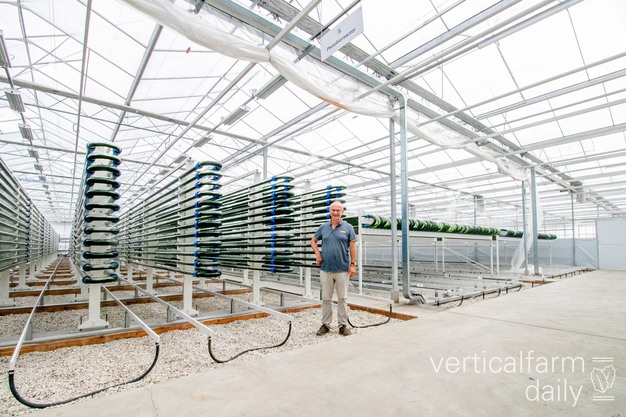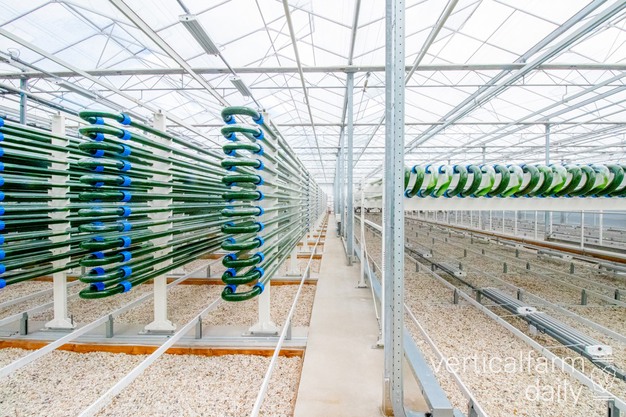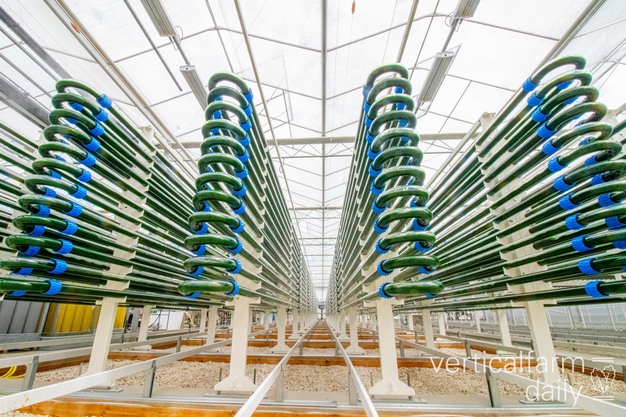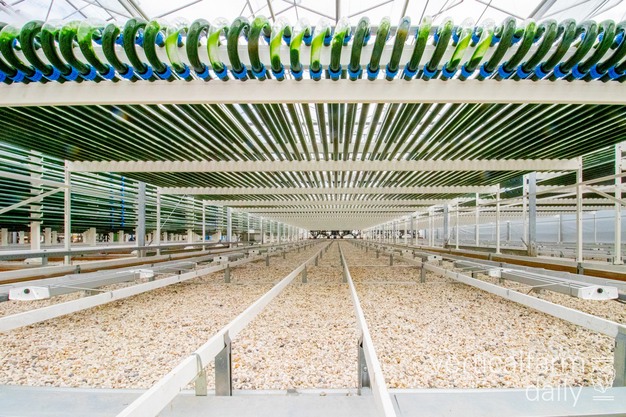Anyone in De Kwakel who gets a chance to look inside Lgem soon sees algae moving around through glass tubes at a fast pace. The systems are fully automated algae cultivation systems, developed in-house. Available in various sizes, starting from 2.5 meters in tube length to systems that can hold tens of thousands of liters of water.
Growing algae in greenhouses began more than 15 years ago. "We have yet to encounter an algae that you cannot grow in our systems," says Eugène Roebroeck who co-founded Lgem and currently leads the science and technology department.
The best-known setups are the two pilots in which Lgem has been cultivating spirulina algae non-stop for the past two and a half years. However, not many know that the company is moving its cultivation indoors, growing without daylight, and using supplemental lighting instead. Together with Synalgae, whom they merged with a few years back, Lgem is working on scaling up and selling systems at a large scale starting from one hectare onwards.
As for the company itself, they scaled up quite considerably. Coming from three people back in 2018 to a team of 20 today. This spring, Navus Ventures announced an investment into the company which cannot be disclosed. According to Eugène, the new indoor cultivation system is definitely a visible result of that. The startup is using the additional financing to, among other things, advance the AlgaeHUB, as they themselves call the demo set-ups in the greenhouse in De Kwakel.

Eugène Roebroeck seen with the pilot setups, one vertical and the other horizontal
Reversed marble track
All of Lgem's systems, whether large or small, operate the same. Early on in the quest for high-tech algae cultivation, the algae growers figured out how to develop a system, that can deploy high-density algae cultivation with a sufficient and critical level of CO2, without the concentration of oxygen produced becoming too high.
The patented method of achieving this is by running both gas and water through the tubes simultaneously, creating a two-phase flow. This is achieved by blowing CO2-enriched air into the tubes, seen by the air bubbles in the tubes, this keeps the algae circulating through the tubes. So without a liquid pump, Eugene emphasizes. After all, not all algae like to be dragged through a pump.
The tubes run slightly upward. Eugène calls it 'an inverted marble slide'. The temperature of the water in the daylight-less growing system is automatically kept stable, A stable temperature and complete control over the light gives unparalleled production results. There is a total of 15 kilometers of glass tubing per system. Our smaller systems can also be cooled or heated via a heat exchanger or double-walled glass tubes.
There, cold or hot water provides temperature control. In addition to CO2, nutrients are added in the form of fertilizers, just as in traditional greenhouse plant cultivation. "What we do is similar to substrate cultivation. With us, however, the algae grow on the substrate, and that is the water." The water can be fresh or salty, depending on the type of algae.

Soft drink
By continuing to regularly dilute the "culture," as the algae specialist calls it, the system does not clog up. Something growers in horticulture sometimes unwittingly have to deal with when algae clog up their water systems. With proper care, an algae culture can last a very long time, even more than 2.5 years in the case of Spirulina.
Some algae have a shorter growth cycle, the Blood Rain Algae, for example. "This kind of algae has to be stressed deliberately to turn it from green to red. This alga is known to produce a powerful antioxidant. You grow the blood rain algae in about three to four weeks after which you harvest the system empty and set up a new crop."
Spirulina is a well-known species of algae that was on the market in Europe before 1997 and therefore does not need "Novel Food" approval from the EU. The spirulina is harvested in the form of an algae paste, which in this case, a soft drink producer uses for a drink. In general, harvesting can be done in two ways, via filtration and centrifugation, which can be automated. Most of the labor, according to Eugene, goes into cleaning the systems. "But Lgem is also on the way to fully automating this process."

24/7 lighting, not heating
Inside the greenhouse there are two different setups of spirulina, one arranged horizontally, and the other vertically. However, there are hardly any production differences between both systems. The algae growers have paid close attention to light distribution and sufficient space in between for natural lighting. In addition, LED lights are hung above the vertical system. For the horizontal system, supplemental lighting is positioned on the floor. "That's more efficient," he says.
For most algae, 24/7 lighting is optimal, the algae specialists at Lgem know. Hence, daylightless setups are now being built. Leaving out free sunlight seems crazy, but it's not for countries where a lot of cheap renewable energy is generated and the outdoor climate can be extreme.
Eugène cites Norway as an example. There, electricity is retrieved from hydropower and is available at low prices. Heating is not required for indoor cultivation. The heat from the lamps, from a Scandinavian supplier, is enough to reach temperatures of 23 to 24 degrees Celsius in the insulated grow hall.
Light is provided at about 400 micromoles per square meter. Even a higher number is possible, yet the question is when algae convert all that light into growth. In any case, the lamps easily achieve the optimal temperature for algae cultivation. "Sometimes you will still have to cool down the growing room, for which we're using colder outside air, for example. Even in cold winters, you can easily achieve the temperatures required for algae cultivation."

Pay attention: the fixtures are positioned underneath the cultivation system as part of a trial Lgem is running
Horticultural parallels
When the indoor facility for algae cultivation, which will be built next to the greenhouse setup in the greenhouse, is finished, Lgem's algae growers will be able to demonstrate how the systems work. It will also allow the algae growers to gain experience in growing without daylight, so they can pass that knowledge on to their customers.
Scaling up the cultivation volume from a smaller to a larger system goes step by step. Lgem itself does the same in De Kwakel. After all, there is always starting material needed to start cultivation. Lgem gets that material from a smaller setup. Could supplying starting material to beginning growers also be another task for Lgem? "The industry still has to mature," says Eugène. "Perhaps then in time, there will be specialized companies for the cultivation of starting material just like in greenhouse horticulture."
Meanwhile, cultivation and testing in the greenhouse setup also continue. "Here we still want to test intermediate lighting." One last horticultural parallel.
For more information:
Eugène Roebroeck
Lgem
+31 (0)85 7604736
info@lgem.com
www.lgem.com
